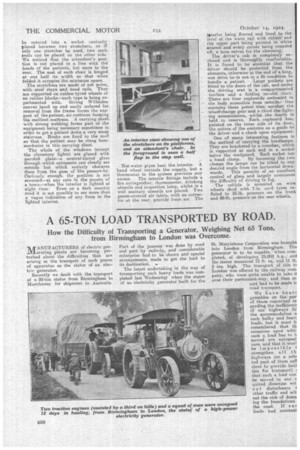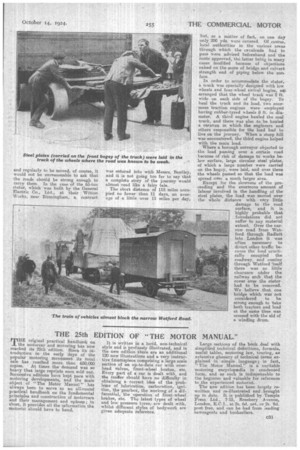A 65-TON LOAD TRANSPORTED BY ROAD.
Page 14

Page 15

If you've noticed an error in this article please click here to report it so we can fix it.
How the Difficulty of Transporting a Generator, Weighing Net 65 Tons, from Birmingham to London was Overcome.
MANUFACTURERS of electric generating plants are becoming perturbed about the difficulties that are arising in the transport of such pieces of apparatus as the stator of an electric generator.
Recently we dealt with the transport of a 50-tan stator from Birmingham to Manchester for shipment to Australia Part of the journey was done by road and part by railway, and considerable enterprise had to be shown and special arrangements made to get the load to its destination.
The latest undertaking in the way of transporting such heavy loads was completed last Wednesday when the stator of an electricity generator built for the St. Marylebone Corporation was brought into London from Birmingham. The generator is to be capable,' a hen completed, of developing 25,000 h.p., and the stator measured 12 ft. sq. and 11 ft. 2 ins. high. The transport Of this to London was offered to the railway corn. pany, who were quite unable to take it over their permanent-way, and then re. sort had to be made tc road transport.
We bave liter( grumbles on the par of those concerned re garding the inefficienc:, of our highways fo the accommodation o such bulky and heav: loads, but it must b remembered that th occasions upon whir such a load has to b moved are extre,mel rare. and that it woul be impossible t strengthen a 11 t h highways (or a selei ted part of them sufl cient to provide leen ties for transport) E that such a load con' be moved :n any r quired direction wit out disturbance t other traffic and wit out the risk of dams ing the foundations the road. If sue loads had constant
and regularly to be moved, of course, it would not be unreasonable to ask that the roads should be strong enough to carry them. In the case of the 65-ton stator, which was built by the General Electric Co., Ltd., at their Witten Works, near Birmingham, a contract was entered into with Messrs. Bentley, and it is not going too far to say that a complete story of the journey would almost read like a fairy tale.
The short distance of 118 miles occupied no fewer than 11 days, an average of a little over 11 miles per day, but, as a matter of fact, on one day only 200 yds. were covered. Of course, local authorities in the various areas through which the cavalcade had to pass were advised beforehand and the route approved, the latter being in many cases modified because of objections raised on the score of bridge and culvert strength and of piping below the sur. lace.
In order to accommodate the stator, a truck was specially designed with low wheels and four-wheel swivel bogies, set arranged that the wheel track was 2 ft. wide on each side of the bogey. To haul the truck and its load, two enor mous traction engines were employed having rubber-tyred wheels 8 ft. in dia meter. A third engine hauled the coal truck, and there was also to be hauled a caravan in which the engineers and others responsible for the load had to live on the journey. When a steep hill was encountered, the third engine helped with the main load.
Where a borough surveyor objected to the load passing over a certain road because of risk of damage to works be low surface, large circular steel plates, of which a large number were carried
on the bogey, were laid, and over these the wheels passed so that the load was spread over a much larger area
Except for the slowness of the proceeding and the enormous amount of labour involved in the handling of the steel plates, the load was moved over the whole distance with very little damage to the road surface, and it is highly probable that foundations did not suffer to any material extent. Over the nar row road from Wat ford through Radlett into London it was often necessary to divert other traffic because the load medi cally occupied the road.way, and coming through Watford 'tself there was so little clearance under the railway arch that the cover over the stator had to be removed. We believe that one bridge which was not considered to be strong enough to take both tractors and load at the same time was crossed with the aid of a winding drum.






























